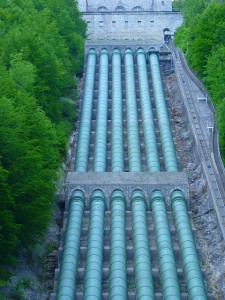 Every American, every day, will use water for a variety of purposes – washing, cooking, gardening, and even play. Yet it is all too easy to forget how valuable this vital commodity is. With U.S. cities going days without safe water, and states suffering drought for consecutive years, the U.S. water system is being strained to its limits. Here are ten things you may not realize about the American water system, and why its important to conserve water whenever we can.
Every American, every day, will use water for a variety of purposes – washing, cooking, gardening, and even play. Yet it is all too easy to forget how valuable this vital commodity is. With U.S. cities going days without safe water, and states suffering drought for consecutive years, the U.S. water system is being strained to its limits. Here are ten things you may not realize about the American water system, and why its important to conserve water whenever we can.
- Americans use, on average, between 100 and 175 gallons of water each, per day. To put this in perspective, an individual in the developing world uses only 2.64 gallons a day on average.
- In every mile of the 1.2 million miles of water mains in the U.S., a break appears every six years on average. However, water pipes are generally not replaced for hundreds of years. Some cities in the U.S. have replacement cycles of 300 years.
- The state of disrepair of the U.S. water system means it is subject to leaks. The system loses about one-seventh of its water. That means a full day’s supply is lost for every week’s worth of water. Calling in a plumber to repair household or main leaks cam reduce waste.
- In 2013, the U.S. put $29 billion into maintaining the infrastructure of its water system. This may seem like a significant sum until you compare it to the $25 billion spent by Americans on bottled water that year.
- With droughts hitting some of America’s largest states, it is hardly surprising that the use of bottled water is on the increase, 2013 saw an all-time high, with 10 billion gallons of bottled water being sold.
- Your home usage can have a dramatic impact on water consumption. For example, energy efficient washing machines use half as much water as other models. Meanwhile, leaving the tap running can waste 3 gallons of water every minute.
- 25 percent of water used in the U.S. is consumed by only four states. Furthermore, only 11 percent of America’s water goes to homes and businesses. The majority of the rest goes into power plants and agriculture.
- Vital reservoirs in the U.S. are running low on water. For example, Nevada’s Lake Mead, which supplies 30 million people, is almost two-thirds empty. Yet in 2000 it was almost full.
- The U.S.cleans and reuses only a fraction of its water – about 8 percent in comparison to Singapore’s 30 percent and Israel’s 70.
- Although water rates are rising year by year, consumers still rarely pay the true value of water. This means water systems cannot receive the care and maintenance that they ideally require. It is painfully apparent that the U.S. water system is in crisis, but what can you do as an individual? Taking care to conserve water and use efficient appliances is a good first step. If everyone is a little more careful with their usage, the system as a whole will benefit significantly.

















